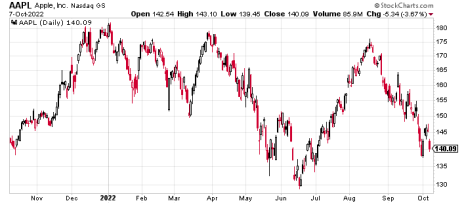We have the opportunity of a lifetime ahead of us! With the S&P 500, Dow Jones and tech-heavy Nasdaq 100 down 23.6%, 19.4% and 31.9% respectively, the world looks like it’s coming to an end for some market participants. But nothing could be further from the truth. In fact, fortunes are made trading options coming out of bear markets.
The problem is no one knows, and will never know, the proper time to start stepping back into the market. But what if we could use an options trading strategy that allowed us to make a return while waiting for a stock or ETF to it a certain level below where it’s currently trading.
We’ve seen some market stalwarts, stocks that are high-quality, blue-chip stocks, get hammered over the past several months, with losses ranging between -50% to -80%.
Again, no one can call a bottom, or top for that matter. But, as investors, we can use probabilities to our advantage and collect premium (a return) to lower the cost basis of a stock that we eventually want to own, again, at the price of our choosing.
[text_ad]
My favorite strategy for trading options to accomplish this task is to simply sell puts.
By selling puts, you are able to produce a steady stream of premium that can be used as a potential source of income or to simply lower your cost basis on the position.
I take this approach every time I wish to purchase a stock or ETF, regardless of if I am “bottom-feeding” or not. And oftentimes, once I am put shares of the stock, or in this case an ETF, I simply sell covered calls against my newly acquired shares and use the wheel approach going forward.
Let’s go over a quick example.
Trading Options to Start an Income “Wheel”
Let’s say you are interested in potentially buying some household names, like Apple (AAPL), but still not at the current price of 140.09.
You prefer to buy AAPL for 115.
Now, most investors would simply set a buy limit at 115 and move on, right? But that approach is archaic. Because you can sell one put for every 100 shares of AAPL and essentially create your own return on capital (depending on the strike you choose).
Some say it’s like creating your own dividend and, in a way, I kind of agree.
A short put, or selling puts, is a bullish strategy for trading options with undefined risk and limited profit potential. Short puts have the same risk and reward as a covered call. Shorting or selling a put means you are promising to buy a stock at the put strike of your choice. In our example, that’s the 115 strike.
If you look at the options chains for AAPL below you will quickly notice that for every 100 AAPL shares we want to purchase at 115, we are able to bring in roughly $1.36, or $136 per put contract sold, every 40 days.
So, by selling the 115 put options in November, you can bring in $136 per put contract, for a return of 1.2% on a cash-secured basis over 40 days. That’s potentially $1,224, or 10.8% annually, per contract. You can use the premium collected from selling the 115 puts either as a source of income or to lower your cost basis.
Just think about that for a second.
You want to buy AAPL at 115. It’s currently trading for 140.09. By selling cash-secured puts at the 115 strike, for $1.36 you can lower your cost basis during that first transaction to 113.64. That’s 18.9% below where the ETF is currently trading, or 42.8% below the highs set back in late 2021. And you can continue to sell cash-secured puts on AAPL over and over, lowering your cost basis even further, until your price target is hit.
In review, by selling cash-secured puts at the 115 strike we receive $136 in cash. The maximum profit is the $136 per put contract sold over 40 days. The maximum risk is that the short 115 put is assigned and you have to buy the stock for 115 per share. But you still get to keep $136 collected at the start of the trade, so the actual cost basis of the AAPL position is, again, 115 – 1.36 = 113.64 per share. The 113.64 per share is our breakeven point. A move below that level and the position would begin to take a loss.
But remember, most investors would have purchased the stock at its current price, unaware there was a better way to buy a security. We rarely take that approach. We know better. We understand we can purchase stocks at our own stated price and collect cash until our price target is hit by using an options trading strategy known as selling puts. It’s a no-brainer. And more importantly, it could allow us to buy stocks at near historic lows and potentially set us up for an opportunity of a lifetime when it comes to long-term profits!
To learn more about the strategies we implement in Cabot Options Institute advisories, subscribe today!
[author_ad]


